"Marvel Zombies" Is A Gross-Out Comedy The Farrelly Brothers Could Only Dream Of Making
By Rob Glenn
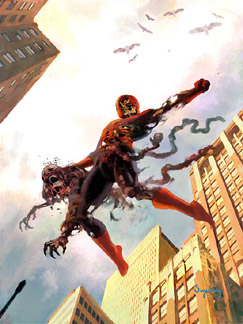 I have to admit that I removed Ultimate Fantastic Four from my pull list a couple of months ago. I was frustrated by the velocity in which the stories flew by. See, one of the strengths that the monthly comic book artform has over graphic novels is similar to what television has over theatrical films: in an ongoing story an artist can take his time and flesh out all the elements to his liking. Unfortunately, in an effort to rack up some history behind the recently re-imagined first family, a lot of details fell by the wayside. They were good stories, but the pace created a "highlight reel" feeling rather than something one could dig into. Denied this seemingly simple need, I dropped the book. That’s how I missed out on the young Reed Richards meeting his elder doppelganger from an alternate dimension. A doppelganger belonging to a dimension infected by a virus approximating zombiosity. Marvel Zombies is a five issue miniseries spin-off from that story with the first issue on your local comic book shelves right now.
I have to admit that I removed Ultimate Fantastic Four from my pull list a couple of months ago. I was frustrated by the velocity in which the stories flew by. See, one of the strengths that the monthly comic book artform has over graphic novels is similar to what television has over theatrical films: in an ongoing story an artist can take his time and flesh out all the elements to his liking. Unfortunately, in an effort to rack up some history behind the recently re-imagined first family, a lot of details fell by the wayside. They were good stories, but the pace created a "highlight reel" feeling rather than something one could dig into. Denied this seemingly simple need, I dropped the book. That’s how I missed out on the young Reed Richards meeting his elder doppelganger from an alternate dimension. A doppelganger belonging to a dimension infected by a virus approximating zombiosity. Marvel Zombies is a five issue miniseries spin-off from that story with the first issue on your local comic book shelves right now.
For those Romero enthusiast, no, these are not real zombies. They run, for one thing. And they talk. Don’t let that deter you, though. Sentient zombies is something that needs some more exploring. In the underappreciated film Return of the Living Dead, the freshly dead experience many stages of zombification with mental faculties intact. These instances in the film make up some of the most effective horror. This sort of aversion/sympathy angle is delved into at length with other monsters like werewolves and vampires but with zombies it seems fresh. Besides, you would think that most Marvel characters would be able to hang onto at least a little of their personalities, what with every third character being a card-carrying genius and all.
Robert Kirkman takes some time off of writing his own zombie line The Walking Dead to pen this series. Kirkman has it a little easier here in that one of the biggest hurdles in writing a horror story is getting your audience to empathize with your victims. This story has an entire stable of long loved characters like Spider-Man, the Hulk, Captain
Whether or not you’ve been following Ultimate Fantastic Four, this comes highly recommended. This is a disturbing, disgusting, amusing read.
FIVE OUT OF FIVE VIKINGS

Words fail in Kyle Baker’s story of Nat Turner
By Graig
 Despite Pulitzer Prizes, increasing mainstream media coverage and countless movie adaptations, our favorite medium still struggles to gain the respect it deserves. Sitting with a friend at lunch this week, having returned from the comic shop with our wares, we were playing a game of “I’ll show you mine if you show me yours” when a coworker sat down and joined us. My friend engaged the co-worker about our passion for comics, but he wasn’t hearing any of it. I said to my friend “you don’t need to justify anything to him,” at which point I tossed the second issue of Nat Turner in front of the coworker and said, “Here’s a comic book retelling the history of a slave rebellion in the 1800’s, how can you argue the artistic merit of that?” “I can argue anything,” he said back in jest, but I could tell he had been defeated and he didn’t want to argue anymore. What’s more, he seemed almost afraid to touch or even look at the comic… perhaps it was the medium, or maybe it was the subject matter, I don’t know. But there’s power in this book, and having since read it a number of times, I can say it stands a testament to the storytelling advantages that comic books have over cinema, television or prose.
Despite Pulitzer Prizes, increasing mainstream media coverage and countless movie adaptations, our favorite medium still struggles to gain the respect it deserves. Sitting with a friend at lunch this week, having returned from the comic shop with our wares, we were playing a game of “I’ll show you mine if you show me yours” when a coworker sat down and joined us. My friend engaged the co-worker about our passion for comics, but he wasn’t hearing any of it. I said to my friend “you don’t need to justify anything to him,” at which point I tossed the second issue of Nat Turner in front of the coworker and said, “Here’s a comic book retelling the history of a slave rebellion in the 1800’s, how can you argue the artistic merit of that?” “I can argue anything,” he said back in jest, but I could tell he had been defeated and he didn’t want to argue anymore. What’s more, he seemed almost afraid to touch or even look at the comic… perhaps it was the medium, or maybe it was the subject matter, I don’t know. But there’s power in this book, and having since read it a number of times, I can say it stands a testament to the storytelling advantages that comic books have over cinema, television or prose.
I picked up the first issue of Nat Turner back in June, having had no background knowledge on the man whose life is the subject of the book, nor of what the book would be like. All I knew was Kyle Baker’s name attached to the cover, and that was good enough for me. I could tell immediately by the cover image that this wasn’t going to be anything like what I usually expect from Baker. The image of a black person’s hand clutching an ornate dagger held aloft in front of the moon, blood spatter arcing over the glowing orb… yeah, I knew it wasn’t going to be at all like hilarious The Cowboy Wally Show or the satirical yet earnest King David.
The entire first issue is free of dialogue, and with the exception of two pages containing actual excerpts from the actual memoirs of a slaver and the confessions of Nat Turner, the book operates on the power of images alone. And one cannot underestimate the power of those images. It doesn’t take long to plough through those first forty-eight pages, however, I have read and reread the first issue dozens of times, absorbing the imagery – the story of Nat Turner’s mother’s capture in Africa, her enslavement, her degradation, her branding, her transport across the ocean, and her sale – and it’s heart-wrenching, and sickening, but it’s also the truth, and truths we should not ignore or deny.
The second issue, still running silent, delves further into some of the horrors that befell the slaves in the early 1800’s in Southampton, Virginia (which isn’t to say that they hadn’t happened before or after), and the imagery of the events in Nat Turner’s life as a boy is aided further by his confessions recorded before his execution. Nat Turner caught onto the written word at a very early age, capable of reading and spelling, and comprehending the messages within the Bible. He was also smart enough to hide his intelligence from the white man. As he grew older, and became more spiritual, routinely fasting and praying, Turner began having communications with “the Spirit”, receiving messages he interpreted as being from God, which he relayed to his enslaved brethren. He soon became convinced of having a purpose, to enact a plan dictated by God himself, and amongst the other slaves he became known as a prophet.
At one point Turner escaped into the woods (as his father had done years before), but to return thirty days later upon the word of God. He returned to his life of servitude, found a partner and sired two children, only to have his family sold and separated. Turner threw himself into his religion, for years seeking true holiness, until the time came when the Spirit revealed itself to him, and he looked up to see the forms of man in the sky. He understood the nature of the environment, of the weather, of the world and was able to interpret them as signals from God. It was through these signals that Turner knew of God’s plan for him and he began preparing his people.
Two more issues remain, with the amazing signal delivered from the sky that led to the insurrection, and the carnage that ensued to come in issue three, with the manhunt for Turner and his trial and execution to come in issue four.
In creating Nat Turner, Baker uses a thick graphite or perhaps charcoal to illustrate the story, reigning in his cartoonist tendencies to evoke something both natural and dynamic. Each page is loosely populated, often with only two or three panels, working at its own pace and rhythm, but combining into a deeply engrossing whole. The Confessions of Nat Turner were used by Baker to adapt the story, and excerpts of the historical record act not as narrative but more as footnotes to the imagery.
As an aside, it strikes me rather peculiar how at nearly the same time God was speaking to Nat Turner, he was also speaking to Joseph Smith, and when one was hanged and skinned, to be remembered as merely a leader of a slave revolt, the other is revered as a prophet and the founder of a officially recognized religion. It makes me wonder what kind of man Turner would have been remembered as had history played out differently. Would he have been seen as an alternative to Joseph Smith or Muhammad?
I hate describing something as “important” but ultimately, the story of Nat Turner, specifically this telling, is just that. For the medium, this ranks right up there with Maus in terms of the power that sequential art can have, and hits even higher in terms of artistic merit. The story is even more important than the art, revealing a powerful historic and religious figure, as well as an event that I’m sure far too few know about, and in Turner’s own words (as interpreted through Baker’s art) no less. Giving the book a 5/5 vikings doesn’t do it enough justice. But…
FIVE OUT OF FIVE VIKINGS
![]()

The Ocean
(Image Comic)
BUY IT HERE!
By Russell Paulette
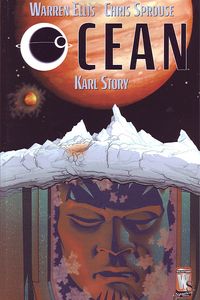 Last December, I wrote about the first three issues of Ocean (RIGHT HERE), and just last month, Wildstorm released the collected edition, with some additional clarifying dialogue by writer Warren Ellis in the final act. The collection also features a cover gallery, sans logo and indicia, as well as some preliminary sketches provided by artist Chris Sprouse.
Last December, I wrote about the first three issues of Ocean (RIGHT HERE), and just last month, Wildstorm released the collected edition, with some additional clarifying dialogue by writer Warren Ellis in the final act. The collection also features a cover gallery, sans logo and indicia, as well as some preliminary sketches provided by artist Chris Sprouse.
The story concerns UN Weapons Inspector, Nathan Kane, who is summoned to Europa to investigate the presence of hundreds of sarcophagi discovered beneath the surface of that moon’s frozen ocean. Little does he know that a megalomaniacal middle-manager for a super-corporation has designs on the sarcophagi, too and so, with the help of a gaggle of pithy compatriots, Kane does what is necessary to prevent these weapons from being activated.
Slapped together under one spine, the issues read incredibly well together—which is a little of why I wrote that merged review this time last year. The pace of the book as a whole is breathless and just rips right along, displaying Ellis’s accustomed flair for dialogue and exciting set-pieces. Ellis’s plotting is concise and lean, working mostly on singular moments between Kane and the evil middle-manager, and kicks into gear in the final act when the ‘splody happens. The additional dialogue helps—particularly at the climax—though, as fuzzy as my memory is of the original issues, the new balloons do smack of hoary exposition. If you think of some of the worst Claremontian examples of an X-Man describing their power as they’re using it—and filter it through some cleverly worded Ellisian dialogue—then you’ve got a notion of the additional material. Nothing totally offensive or disruptive to the reading experience, but the material does still smack of spelling it out for the lowest common denomenator.
Sprouse’s artwork, like Ellis’s plotting, is lean, clear, and capable. He’s an extremely satisfying gestural artist, getting the most out of facial expression and body language—which is key in building the tension in the talky middle third of the book. His ability to convey zero-gravity gunfighting is particularly exciting, as the energy flows from panel-to-panel in a way that speaks to his effortless ability with the pencil.
Overall, it’s a satisfying read—particularly collected together. Like most of Ellis’s work, it’s worth it to wait-for-the-trade, as has become the clichéd parlance. Fortunately for those of you who did, picking up Ocean will give you a bang for your buck, with much more beneath the surface.
FOUR AND A HALF OUT OF FIVE VIKINGS

Jet Pack Pets
(Amaze Ink)
BUY IT HERE!
by Graig Kent
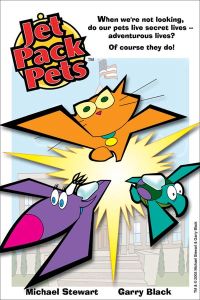 It’s not easy to review something that you’re not the target audience for, and I’m 100% certain that Jet Pack Pets was not created with the pushing-thirtysomething crowd in mind. This is a dead giveaway since the back cover blurts “The Jet Pack Pets first appeared in Disney Adventures magazine”, a periodical which, unless you have a child under the age of six in your household, I’d be surprised to find on your routine reading list.
It’s not easy to review something that you’re not the target audience for, and I’m 100% certain that Jet Pack Pets was not created with the pushing-thirtysomething crowd in mind. This is a dead giveaway since the back cover blurts “The Jet Pack Pets first appeared in Disney Adventures magazine”, a periodical which, unless you have a child under the age of six in your household, I’d be surprised to find on your routine reading list.
So yes, the JPP was created for the youngsters, the wee ones, and not for me. Can I, as reviewer, look at it objectively enough to determine its worth? Well, yes, and no. On the one hand I recognize that the simplistic line work, the vibrant colors, and the cutesy stories (all between one and eight pages in length) in this compilation is going to be attractive to a certain demographic of undiscerning pre-pre-tweens, and even as an almost-thirtysomeone I found the kitschy title and Cartoon Network/Nickelodeon style illustrations to be attractive enough to pick the book off the shelves. On the other hand, actually reading this thing, I can’t seem to distinguish it from being anything other than a Powerpuff Girls knock-off, minus the inspired zaniness. You have a trio of cutesy flying heroes taking on unusual villains or just helping save the day, products of an ingenious professor, and saving the day when the town’s mayor, police captain, and fire chief are helpless (each of whom has that helpless adult buffoon thing going on).
Ultimately, it is for the kids, and altogether it is an attractive package in that regards. I’m sure the little ones will actually find the JPP’s similarity to the Powerpuff Girls (or any other cartoon or comic) to be a benefit, rather than a detractor.
THREE OUT OF FIVE VIKINGS
The OMAC Project
(DC Comics)
BUY IT HERE!
By Russell Paulette
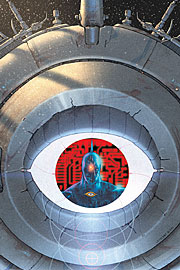 Last March, when all this Countdown to Infinite Crisis hullabaloo began, Devon gave a full thumbs-up to the one-shot that set everything in motion (RIGHT HERE), while I similarly crowed about Greg Rucka and Jesus Saiz’s first issue of The OMAC Project (RIGHT HERE). The collection, from this past October, not only includes the entire mini-series, but also the one-shot, and a significant issue of Wonder Woman, which directly affects the mini-series smack-dab in the middle of it all. How does it shape up under one cover?
Last March, when all this Countdown to Infinite Crisis hullabaloo began, Devon gave a full thumbs-up to the one-shot that set everything in motion (RIGHT HERE), while I similarly crowed about Greg Rucka and Jesus Saiz’s first issue of The OMAC Project (RIGHT HERE). The collection, from this past October, not only includes the entire mini-series, but also the one-shot, and a significant issue of Wonder Woman, which directly affects the mini-series smack-dab in the middle of it all. How does it shape up under one cover?
Rucka’s plot—with much assistance, to be sure, by DC editorial and the other Countdown stalwarts, Judd Winick and Geoff Johns—focuses on the DC spy organization, Checkmate. Having been corrupted from within by Maxwell Lord, who has given Checkmate the mandate to actively seek all the information they can on metahuman activity using Brother I, a stolen Batman-designed satellite, Lord—ahem—lords his power over the superhuman community. When he kills a major DC hero, bringing all sorts of attention—as well as the intruding Superman/Wonder Woman crossover, which effectively ending what power he holds—the series takes a turn, placing Brother I in the antagonist role, fulfilling Lord’s eugenic legacy in the form of OMAC robots.
For the most part, Rucka has a thankless job, presenting a mini-series that is meant to position one of the antagonists for Infinite Crisis and, therefore, naturally lacks an ending. That the plotline spills over into yet-another crossover is considerably annoying, but the trade paperback does its best to orient the readers, giving summaries of the issues not included catching you up-to-date on what you missed between the pages. That said, it’s kind of a mess—the plot is all over the place, and the series jumps around with which heroes it decides it wants to focus on. Mostly, Rucka keeps a handle on it—his point of view is often with the plight of Checkmate agent, Sasha Bordeaux, and her struggle at maintaining a semblance of order in the crumbling spy organization. However, keeping the focus on Batman’s former bodyguard doesn’t keep this thing from being a tangled mess—and make no mistake, it remains one.
But (he offered, weakly), it is fun. For those who care for the window dressing and for following all the players and their associated scorecards, Rucka and Saiz take you on an unrelenting roller-coaster ride with robots, hero-deaths and hero-killings—a world where alliances shift like sand, and the only saving grace is the hail-mary, team-up plan that’s likely certain death if it weren’t, you know, the saving grace.
For his part, Saiz does an able-bodied job keeping things straight-forward and cleanly told. He’s the largest contributing artist on this volume, but it also includes some capable-if-unispiring art from Cliff Richards filling in the gaps, as well as a legion of artists doing able-bodied on the Wonder Woman and Countdown issues, respectively.
Overall, for what it is, it hangs together more nicely than most of the DC Countdown minis, partly because of Rucka’s ability to keep juggling too many balls in too many courts. He may drop a few, but with the ones he keeps in the air, he makes it look so easy that you forget about the few bouncing around your feet.
THREE AND A HALF OUT OF FIVE VIKINGS

Spider-Man: New Avengers
(Marvel)
BUY IT HERE!
By Russell Paulette
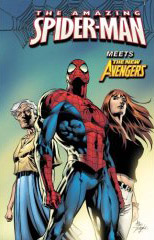 I’ll admit, I had my hesitations with the New Avengers arc when it began back in March (RIGHT HERE), but upon completion and collection, I have to say that J. Michael Straczynski managed to pull it together. Not that it was perfect—and much of my uninspired criticism of the first issue still applies to the run as a whole, and this collection in particular—but it did have some good stuff going for it.
I’ll admit, I had my hesitations with the New Avengers arc when it began back in March (RIGHT HERE), but upon completion and collection, I have to say that J. Michael Straczynski managed to pull it together. Not that it was perfect—and much of my uninspired criticism of the first issue still applies to the run as a whole, and this collection in particular—but it did have some good stuff going for it.
Coinciding with his entrance into the ranks of the New Avengers, Peter, May and MJ are invited to live in Stark Tower following the destruction of May’s Queensboro home. Straczynski uses this as an opportunity to introduce a host of subplots, most of them on the goofy side—May and Jarvis, Tony Stark’s butler, make eyes at each other because, y’know, they’re both old; while Wolverine consistently hits on Mary Jane because, y’know, he likes redheads; oh, and Mary Jane is caught by a paparazzi outside Stark Tower in the middle of the night which leads to, y’know, gossip-rag scandal. Meanwhile, Spider-Man is taking it upon himself, largely, to stop Hydra from poisoning the Ogallala Reservoir with a disease-filled Hydra rocket. Oh, Hydra—when will you learn that these master plans never work!
The true effectiveness of this arc, particularly, is in how straightforward it is with its 80s-era plot. Spider-Man crawls around a penthouse, then follows the businessman down a long elevator into subterranean Hydra compound, where he steals a Hydra uniform and sits in on the briefing describing the plot—this is the level of sophistication we’re working on, here, as Spider-Man employs Austin Powers-level tactics. But you know what? It basically works, as Straczynski doesn’t provide any knowing winks and just plays it for what it is. “Oh, he’s with the Avengers now? Okay, insert evil-organization-takes-over-the-world plot.”
Artwise, I’m still not wowed by Mike Deodato—but at least he’s consistent. He’s comfortable with handling Straczynski’s expositive scenes, as well as the action and web-slinging. His storytelling is clean, considered and (mostly) effective. It just doesn’t excite me the way that Marvel feels that it should. And, in that sense, it’s a lot like the last pair of clean underwear in the drawer—gets the job done, but you kinda wish you had an alternative.
Overall, the arc hangs together pretty well. Perhaps wearing out its welcome by an issue or two, Straczynski keeps the plot moving forward, with some nice twists and turns, while maintaining an effective balance between in-the-suit conflict and the back-at-home subplots. Just when one starts to look thin, the other rises and takes prominence, and back and forth until we’re done. On that pure craft level, the book deserves a notice—if you can get back some of the sillier Hydra elements, that is.
THREE OUT OF FIVE VIKINGS

Astonishing X-Men
(Marvel)
BUY IT HERE!
By Russell Paulette
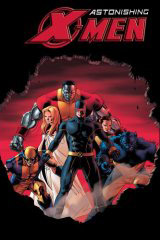 Knowing I can’t match the sheer joy of Devon’s review of the first issue of the latest collection of Astonishing X-Men (RIGHT HERE), I’ll just lead with the notion that, yes, the collection shapes up as good as the last one, and perhaps maybe a hair better. Joss Whedon’s airtight scripting and John Cassaday’s refined linework make volume two of their run, “Dangerous,” a truly wonderful chunk of X-Men action.
Knowing I can’t match the sheer joy of Devon’s review of the first issue of the latest collection of Astonishing X-Men (RIGHT HERE), I’ll just lead with the notion that, yes, the collection shapes up as good as the last one, and perhaps maybe a hair better. Joss Whedon’s airtight scripting and John Cassaday’s refined linework make volume two of their run, “Dangerous,” a truly wonderful chunk of X-Men action.
And action is the word, as Whedon pulls out the visual punches for this volume. Starting with the mystery of a death in the Danger Room, Whedon’s plot involves the introduction of an enemy who strikes at the X-Men from very close to home, with preternatural knowledge of all of their strategies and fighting abilities. After succumbing to an embarrassing defeat in their own home, the team tracks down this renegade villain to the wastelands of Genosha and a blockbuster-level slugfest occurs, culminating in Xavier getting down and dirty with an ax, my friends. It’s like Whedon constructed his plot out of a wish-list of X-moments that fans have either always wanted to see, or always wanted to see done well.
On top of some pretty spectacular set-pieces, Whedon dials it in with the characterization and dialogue—which have become benchmarks of his writing. From the pithy one-liners that deliver a chuckle, to the quiet, reunion moment between long-lost lovers, Whedon is adept at making the most hay out of whatever available humor and pathos the plot brings him. And, as if that wasn’t enough, he usually zings with some pretty tremendous cliffhangers, particularly at this volume’s close—which only whets the palate for more come this February’s issue # 13. For longtime X-enthusiasts, or people looking to take a sample from the movies, you’d be hard-pressed not to be hooked on Whedon’s scripts.
But one look at Cassaday’s sumptuous visuals would be all you would really need. From the subtle costume redesigns—which, somehow, manage to make full-body jumpsuits not look gay…er, well, look less gay at any rate—to the big cinematic moments, Cassaday prepares the reader for grandeur with every panel. Wanna see Xavier seethe with radiating hatred? Gotcha covered. How about Wolverine slicing the hide of a seventy-foot tall gila monster with the Fantastic Four at his side? Check. How about Beast going feral and chomping on the tibula of a robot villain? You’re all set, Pepe. Cassaday’s got it all in spades, and its gorgeously colored by Laura Martin, too, so hop to it and buy this thing already!
A seriously fine piece of craftsmanship from a delicately dedicated writer and his gorgeously talented artistic partner, you’d be hard pressed not to find their work together something of note.
FIVE OUT OF FIVE VIKINGS

![]()

 Seven Soldiers: Mister Miracle #2 (DC) – Oh boy, this is easily the weakest series within the Morrison Seven Soldiers project. I may have graded the Bulleteer lower, but this is just head scratching. With issue two, Morrison further explains that the classic Kirby-created New Gods had a little incident and the beings of New Genesis are now all inhabiting the bodies of street people, while the acolytes of Apocalypse are urban mafioso. This re-imagining of the New Gods seems to be Morrison’s only point of interest with the book and the character of Mister Miracle seems an arbitrary one. The concept seems almost distinct from the idea of the Seven Soldiers (as Darkseid would usually be the be “the big bad” of a story on his own) and unless you’re boned up on your “Fourth World” folklore I’m not sure that this is otherwise all that interesting. That’s not even to mention the dramatic art shift from Pasqual Ferry last issue to Billy Dallas Patton (does he sound like a pro wrestler to anyone else?) for most of this issue to Freddie Williams II for the last four pages. None of the styles are consistent with one another, despite colorist Dave McCaig’s efforts. It’s pretty much a mess. –Graig
Seven Soldiers: Mister Miracle #2 (DC) – Oh boy, this is easily the weakest series within the Morrison Seven Soldiers project. I may have graded the Bulleteer lower, but this is just head scratching. With issue two, Morrison further explains that the classic Kirby-created New Gods had a little incident and the beings of New Genesis are now all inhabiting the bodies of street people, while the acolytes of Apocalypse are urban mafioso. This re-imagining of the New Gods seems to be Morrison’s only point of interest with the book and the character of Mister Miracle seems an arbitrary one. The concept seems almost distinct from the idea of the Seven Soldiers (as Darkseid would usually be the be “the big bad” of a story on his own) and unless you’re boned up on your “Fourth World” folklore I’m not sure that this is otherwise all that interesting. That’s not even to mention the dramatic art shift from Pasqual Ferry last issue to Billy Dallas Patton (does he sound like a pro wrestler to anyone else?) for most of this issue to Freddie Williams II for the last four pages. None of the styles are consistent with one another, despite colorist Dave McCaig’s efforts. It’s pretty much a mess. –Graig
RATING: 
 Skyscrapers of the Midwest #1 (adHouseBooks) – A winner at the Alternative Press Expo in 2004, Joshua W. Cotter brings his Mini-Comic to full-size, and, quite frankly, I don’t get it. That’s not to say I don’t understand what’s happening in the book, a collection of short stories using anthropomorphic cats or robots to relate the experience of growing up in remote farmlands of middle-America. Yes, I understand that… but why robots and kittens? And why juxtapose the somber tales of abusive, alcoholic fathers or grandmothers who died from cancer with crassly funny letter columnist “Skinny Kenny” or satirical ads for cigarettes or an alternative to Boy Scouts? While I dig the latter, I’m not too keen on the former. The bitingly funny is the good stuff, the bleak stories with robots and cats wearing jackets and scarves I’m not so into (it’s like emo in comics form). Cotter’s art is quite stunning, however, his ink line containing a smidge of R. Crumb, but having the overall esthetic of woodcut prints. –Graig
Skyscrapers of the Midwest #1 (adHouseBooks) – A winner at the Alternative Press Expo in 2004, Joshua W. Cotter brings his Mini-Comic to full-size, and, quite frankly, I don’t get it. That’s not to say I don’t understand what’s happening in the book, a collection of short stories using anthropomorphic cats or robots to relate the experience of growing up in remote farmlands of middle-America. Yes, I understand that… but why robots and kittens? And why juxtapose the somber tales of abusive, alcoholic fathers or grandmothers who died from cancer with crassly funny letter columnist “Skinny Kenny” or satirical ads for cigarettes or an alternative to Boy Scouts? While I dig the latter, I’m not too keen on the former. The bitingly funny is the good stuff, the bleak stories with robots and cats wearing jackets and scarves I’m not so into (it’s like emo in comics form). Cotter’s art is quite stunning, however, his ink line containing a smidge of R. Crumb, but having the overall esthetic of woodcut prints. –Graig
RATING: 
 Legion of Superheroes #12 (DC) – The penultimate chapter to the inaugural story in this Legion of Superheroes relaunch. Mark Waid and Barry Kitson bring it on home as the battle plans have been drawn, the tactics have been relayed and the war hits its fever pitch. Not to mention that total “eff yeah” moment on page 12. The Legion tower has been decimated, but Braniac 5 is Davey to his enemy’s Goliath. Meanwhile, a small strike force of Legionnaires engages thousands of enemies with such gusto that even though they can’t win, for some reason they believe they can’t lose. And Cosmic Boy speaks to the galaxy like he’s Christian Slater in Pump Up The Volume. What I like about this book: stuff actually happens. If you call yourself a superhero fan and you’re not reading this, then you should hang your head in shame as you walk to the comics shop to pick up the recently released trade. –Graig
Legion of Superheroes #12 (DC) – The penultimate chapter to the inaugural story in this Legion of Superheroes relaunch. Mark Waid and Barry Kitson bring it on home as the battle plans have been drawn, the tactics have been relayed and the war hits its fever pitch. Not to mention that total “eff yeah” moment on page 12. The Legion tower has been decimated, but Braniac 5 is Davey to his enemy’s Goliath. Meanwhile, a small strike force of Legionnaires engages thousands of enemies with such gusto that even though they can’t win, for some reason they believe they can’t lose. And Cosmic Boy speaks to the galaxy like he’s Christian Slater in Pump Up The Volume. What I like about this book: stuff actually happens. If you call yourself a superhero fan and you’re not reading this, then you should hang your head in shame as you walk to the comics shop to pick up the recently released trade. –Graig
RATING: 
Think You Have What it Takes to Be a Warrior-Scribe?
 We’re going to be looking for another reviewer in the near future. Details will be forthcoming. This is just an early heads-up. As was the case during the last go-around (when we picked up Graig, Russell and Rob) you’ll be asked to review about four comics (at least two of which will be pre-selected by us ahead of time so as to create a level basis for comparison) under a specific time schedule. Just want you to be aware ahead of time of what it will basically entail.
We’re going to be looking for another reviewer in the near future. Details will be forthcoming. This is just an early heads-up. As was the case during the last go-around (when we picked up Graig, Russell and Rob) you’ll be asked to review about four comics (at least two of which will be pre-selected by us ahead of time so as to create a level basis for comparison) under a specific time schedule. Just want you to be aware ahead of time of what it will basically entail.
We’re looking for someone talented, creative, dependable and proficient with either a battle-axe or a double-handed sword. Frost Giants need not apply (unless their comic reviewing skills are top-notch, of course).
So ends this accounting of valiant warriors and high adventure! Return next week to honor still more comics. Praise Odin.
HAVE A COMIC YOU WANT TO SUBMIT FOR REVIEW? Contact Sean at scfahey@yahoo.com.
To discuss this column and all things Nordic, you may contact Sean at scfahey@yahoo.com ,